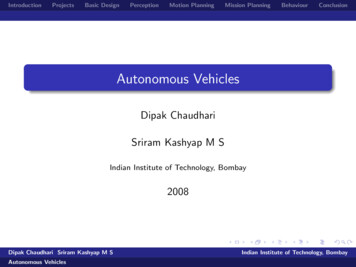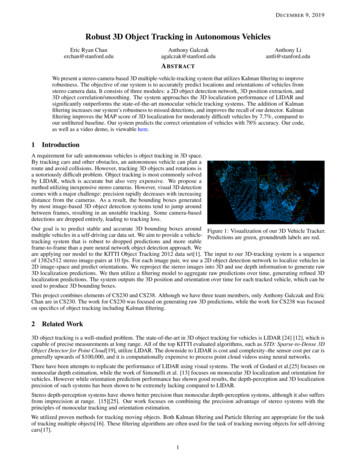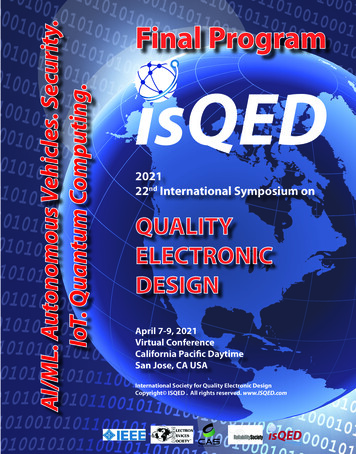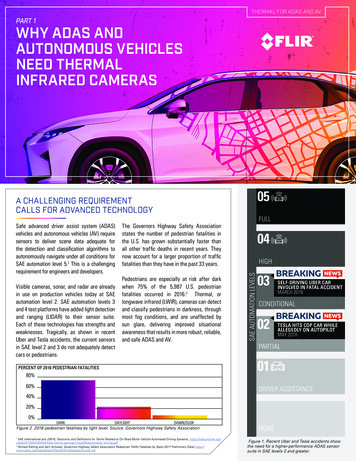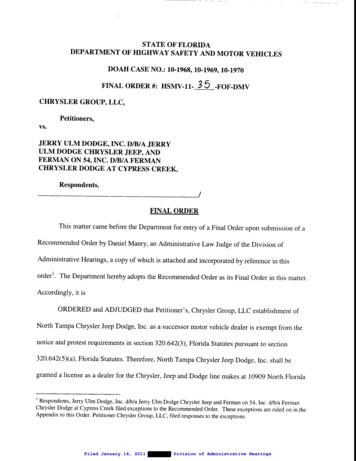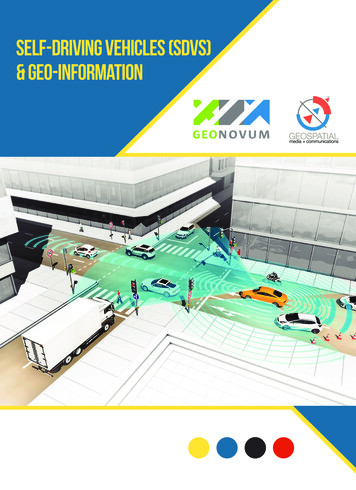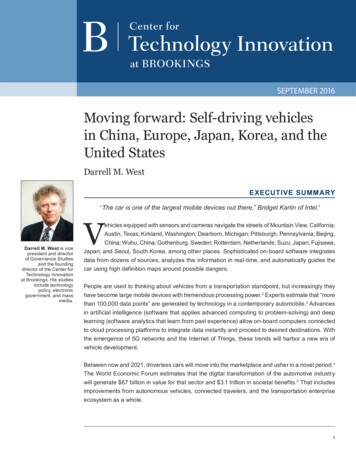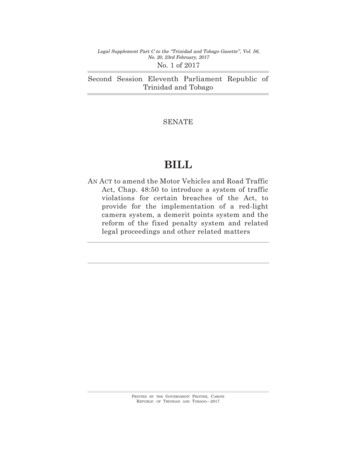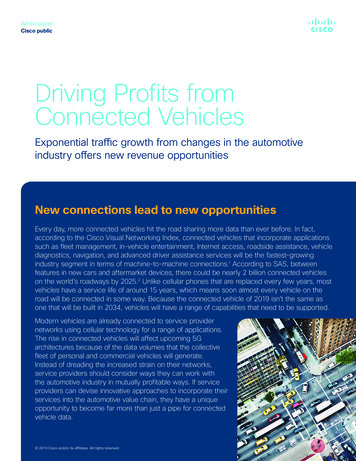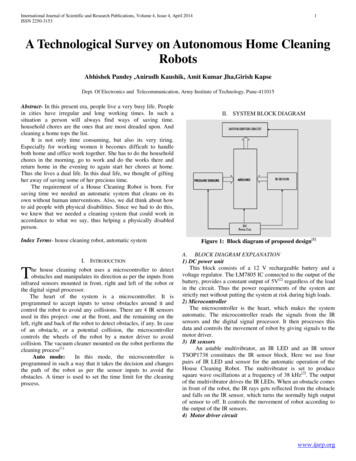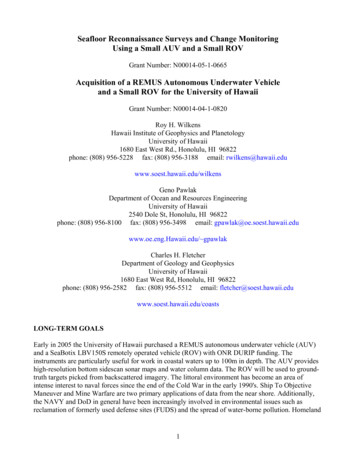
Transcription
A u t o n o m o u s Ve h i c l e s :Navigating the legal and regulatory issuesof a driverless world
Table of ContentsIntroduction SAE Levels Physical Ecosystem Strategic PartnershipsLegal Issues Regulatory Product Liability Cybersecurity and Data Privacy Intellectual PropertyCase Study Keolis – AVs in PublicTransportation2
Introduction
Introduction 10 million autonomous vehicles will hit the roads by 2020 In 10 years fully autonomous vehicles will be the norm AVs will generate a 7 trillion annual revenue stream by 2050 Widespread adoption of AVs could lead to a 90%vehicle -revenue-u-s-study-idUSKBN0M10UF20150305in
History of Autonomous VehiclesIntroductionof CruiseControlFCC allocates 75MHz of spectrumto DedicatedShort RangeCommunications19481999Googlebegins selfdriving carprojectGoogle’sautonomouscar passes a14-miledriving test inNevadaTeslareleases itsAuto-Pilotself-drivingmode200920122015Uber hires 40Carnegie Mellonrobotics researchersto work onautonomous vehicles;Ford begins testing itsself-driving cars inCA, AZ, MINHTSA issuesrevised safetyguidelines forautonomousvehicles201720152007201320132016Teams createvehicles that selfnavigate a 60-milecourse as part ofDARPA “GrandChallenge”Mercedes andInfiniti producecars with radarsensors andsomeautonomousdriving featuresNHTSAreleasesinitial policyonautonomousvehiclesMajor acquisitionsand partnerships (GMand CruiseAutomation; GM andLyft; Toyota andJaybridge Robotics;Uber and Volvo)2016NHTSA issuesguidelines fortesting anddeployment ofautonomousvehicles
SAE Levels of AutomationSource: ted-vehicles-safety
Basic Physical Ecosystem of an Autonomous Vehicle Global Positioning System (GPS) Light Detection and Ranging(LIDAR) Cameras (Video) Ultrasonic Sensors Central Computer Radar Sensors Dedicated Short-RangeCommunications-Based Receiver(not pictured)Source: The Economist, “How does a self-driving car work?”
Key Physical Components of Autonomous Vehicles Cameras – Provide real-time obstacle detection to facilitate lane departure and trackroadway information (like road signs). Radar – Radio waves detect short & long-range depth. LIDAR – Measures distance by illuminating target with pulsed laser light and measuringreflected pulses with sensors to create 3-D map of area. GPS – Triangulates position of car using satellites. Current GPS technology is limited to acertain distance. Advanced GPS is in development. Ultrasonic Sensors – Uses high-frequency sound waves and bounce-back to calculatedistance. Best in close range. Central Computer – “Brain” of the vehicle. Receives information from variouscomponents and helps direct vehicle overall. DRSC - Based Receiver – Communications device permitting vehicle to communicatewith other vehicles (V2V) using DSRC, a wireless communication standard that enablesreliable data transmission in active safety applications. NHTSA has promoted the use ofDSRC.
Companies Investing in Autonomous VehiclesVehicles operating in SAE levels of automation 1-3 are already in commercial use andmany companies are investing further in developing highly and fully automated vehicles44
Strategic Partnerships
Recent Developments January 2017 – Keolis and NAVYA, in partnership with the city of Las Vegas,launched the first autonomous, fully electric shuttle to be deployed on a publicroadway in the United States. January 2018 – Toyota announces “e-Palette” concept vehicle which is a fully electricautonomous vehicle that can be customized by a partner for applications such asfood deliveries (Pizza Hut), ride-sharing (Uber), or store fronts (Amazon). January 2018 – Udelv, a Bay Area tech company, completed the first delivery ofgoods by a self-driving car when it delivered groceries in San Mateo. February 2018 – Hyundai announced that a fleet of its fuel cell electric cars made asuccessful fully automated trip from Seoul to Pyeongchang. This is the first time aLevel 4 car has been operated with fuel cell electric cars.
Legal Issues Around Autonomous Vehicles Regulations Liability Personal Injury Cybersecurity and data breaches Intellectual property ownership
Federal and StateRegulations
Federal Regulation of Autonomous VehiclesFederal Motor Vehicle Safety Standards The National Highway Traffic Safety Administration (NHTSA) within the Departmentof Transportation (DOT) specifies minimum safety performance requirements formotor vehicles and equipment. Automakers must certify compliance before sellingvehicles. Fully autonomous vehicles (and some highly autonomous vehicles) would not meetcurrent Federal Motor Vehicle Safety Standards (FMVSS) (i.e., if manufacturersseek to design vehicles without mirrors, bumpers, braking pedals, and otherfeatured required by the FMVSS). NHTSA can approve a limited number of exemptions from the FMVSSs. NHTSA also can approve importation of autonomous vehicles that do not meetFMVSSs for testing, subject to conditions.
Federal Regulation of Autonomous Vehicles DOT released new guidance on autonomous vehicles in September 2017, titled“Automated Driving Systems (ADS) 2.0: A Vision for Safety”. Replaces guidanceissued in 2016 by Obama DOT. Guidance identifies 12 safety elements: (1) system safety; (2) operational designdomain; (3) object and event detection and response; (4) fallback (minimal riskcondition); (5) validation methods; (6) human machine interface; (7) vehiclecybersecurity; (8) crashworthiness; (9) post-crash ADS behavior; (10) datarecording; (11) consumer education and training; and (12) federal state and locallaws. Recommends that entities involved in ADS testing and deployment demonstratehow they address the 12 safety elements by publishing a Voluntary Safety SelfAssessment.
Federal Regulation of Autonomous Vehicles NHTSA, the Federal Highway Administration (FHWA), and the Federal TransitAdministration (FTA) have sought comments related to autonomous vehicles NHTSA requested comments on regulatory barriers to Automated SafetyTechnologies, and testing and compliance certificationFHWA requested comments on what is needed to accommodate ADS technologiesand maximizing their potential benefits in the transportation networkFTA requested comments on current and near-future status of automated transitbuses and related technologies, with the goal of informing FTA’s efforts to promotedevelopment of ADS in the public transit sector Deadline for filing all comments was March 5, 2018
Federal Legislation Governing Autonomous Vehicles Congressional efforts underway to amend current law regarding regulation ofautonomous vehicles House and Senate bills have similar objectives: Susan – This contentdifferent than the samshortened version. Dreplace this with the lslide 10 of the other dAuthorize NHTSA to issue more exemptions from FMVSSs (up to 100,000 vehiclesper year within three years after enactment)Require NHTSA to update FMVSSs to accommodate autonomous vehicles;Require mandatory safety assessment reporting of the elements similar to those inDOT’s voluntary safety assessment reportInclude cybersecurity and privacy requirementsPreempt state regulation of safety but preserve state role to regulate licensing,registration, insurance, and other traditionally state functions House passed its bill in late 2017 Senate bill is on hold while senators work through issues regarding privacy,cybersecurity and safety
State Laws Governing Autonomous Vehicles 23 states and the District of Columbia have passed legislation governingautonomous vehicles (Alabama, Arkansas, California, Colorado, Connecticut,Florida, Georgia, Illinois, Indiana, Louisiana, Michigan, New York, Nevada, NorthCarolina, North Dakota, Pennsylvania, South Carolina, Tennessee, Texas, Utah,Virginia, Vermont, and Washington D.C.). 10 additional states have executive orders in place issued by their governorsrelating to autonomous vehicles (Arizona, Delaware, Hawaii, Idaho, Maine,Massachusetts, Minnesota, Ohio, Washington, and Wisconsin). Arizona, California, Florida, Michigan, and Nevada have been most active. For a comprehensive review of state laws enacted islation.aspx#enacted
Product Liability
Liability for Autonomous Vehicle Accidents Will courts l treat autonomous vehicles as drivers and apply a negligence standardor as sophisticated technology and apply a product liability standard? How will liability be apportioned? Fleet Operator/Service ProvidersVehicle manufacturersTechnology companies/software manufacturersLocal government’s responsible for maintaining infrastructure
Product Liability: State LawsFlorida, Michigan, Nevada and the District ofColumbia shield manufacturers from liability fordamages resulting from third party conversion ofvehicle into autonomous vehicle, except wheredamages are caused by defect present in vehicle asoriginally manufactured.
Managing Liability Among Parties Warranties and indemnifications should clearly define scope, responsibility andliability Responsibility for maintenance, repairs and updates should be defined Liability between automaker, technology company and vehicle owner/operatorshould be defined Responsibility for compliance with federal, state and local laws and regulationsshould be defined
Cybersecurity
Potential Attack Gateways Electrical Control Units (ECUs) Airbag, Advanced Driver AssistantSystem, Engine, Steering & Brakes,etc. On-Board Diagnostics (OBD) IIDiagnostic Port Dedicated Short-RangeCommunications-Based Receiver USB Ports Passive Keyless Entry/ Remote Key Remote Link Type AppSource: Telematics Wire: Cybersecurity – A Gating Issue for Safety in AConnected and Automated Vehicle Future Tire Pressure Monitoring System(TPMS)
Explanation of Key Attack Gateways Electronic Control Units (ECUs) – ECUs are embedded systems that control one or moreelectrical systems or subsystems within a vehicle and are connected via an internalnetwork. They control systems like the engine and transmission, steering and brakes,infotainment, lighting, etc. Risks arise when access to ECUs (usually peripheral ECUs likean infotainment system) are breached and malicious actors are able to access certainECUs or the whole network. Vehicles today have up to 100 ECUs onboard. OBD II Diagnostic Port – Every car manufactured after 1996 and sold in the U.S. musthave an OBD II installed. The port was originally mandated to permit monitoring ofemissions, etc. It is increasingly used to facilitate non-diagnostic features like enabling WiFi, or enabling an insurance company to track usage through attachment of a “dongle” tothe port. These ports can provide a means of access for attackers into an otherwise securesystem. DSRC-Based Receivers – DSRC is being promoted as a means of encouraging V2V andvehicle-to-infrastructure (V2I) communications. The short-wave communications can besubject to spoofing and other attacks. There’s now a push to move to more advanced 5Gbased communications.
Common Security Vulnerabilities Software Glitches – Connected vehicles today contain more than 100 million lines ofcode. More code means more opportunity for bugs and mistakes. Glitches, even wheninadvertent, can be exploited. No Single Source of Knowledge of or Control Over Source Code – Software fordifferent components of connected vehicles is being written by different developers,installed by different supplies, and no one source has knowledge of or control over thesource code. Increase Use of Apps Leave Vulnerabilities – Consumers are using an increasingnumber of smartphone apps to interface with their connected cars and help run certainfunctions. Researchers have already demonstrated weaknesses in some of these apps.Likely to see spread in use of malware. Need for Constant Updates May be Overlooked – With the increased use of connectedfeatures comes an increased need for continuous updates to fix glitches and help protectvehicles. There is a risk these updates could be overlooked or that malicious actors couldinfect routine updates.
Cybersecurity Threats and Concerns The same types of attacks that are possiblein any connected device are generallypossible in connected vehicles once accessis gained. For example – Denial-of-service (DoS)attacks (e.g., utilizing the Controller AreaNetwork (CAN) Bus system), remote accessand control (e.g., the 2015 Jeep event),man-in-the-middle (MiM) attacks, etc.Source: CNN: Jeep remotely carjacked, shut down onhighwayThe 2015 white hat attack on a JeepCherokee led to the recall of 1.4 millionvehicles and highlighted risks. The difference between attacks like theseagainst common IoT devices and attackswithin a connected or autonomous vehicleis the likelihood for increased risk to life andproperty in the vehicle context.
Consumers Desire and Fear ConnectivityIn 2014, McKinsey conducted a survey of 2,000 new-car buyers in Brazil, China,Germany, and the U.S. about connected car issues. The survey remains interestingfor the disjoint it highlights between consumer desire for connectivity and consumerfear of the possibility of attacks as a result of that connectivity. 13% of car buyers are no longer prepared to even consider a new vehicle without Internetaccess. More than ¼ of car buyers now prioritize connectivity over features like engine power and fuelefficiency. 45% of U.S. car buyers are reluctant to use car-related connected services because theywant to keep their priva
Key Physical Components of Autonomous Vehicles Cameras – Provide real-time obstacle detection to facilitate lane departure and track roadway information (like road signs). Radar – Radio waves detect short & long-range depth. LIDAR – Measures distance by illuminating target with pulsed laser light and measuring reflected pulses with sensors to create 3-D map of area.File Size: 2MBPage Count: 61Explore furtherAutomated and Autonomous Driving - Stanford Universitycyberlaw.stanford.eduIssues in Autonomous Vehicle Testing and Deploymentcrsreports.congress.govAutonomous Car PPT Self Driving Car Downloadwww.topicsforseminar.comWhat is Google Driverless Car (PPT Report & Analysis) 2021throttlebias.com(PDF) Autonomous Cars: Past, Present and Future - A Review .www.researchgate.netRecommended to you based on what's popular Feedback
